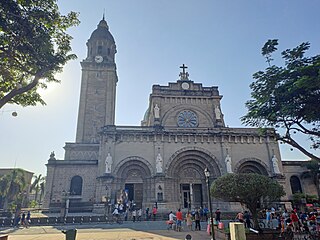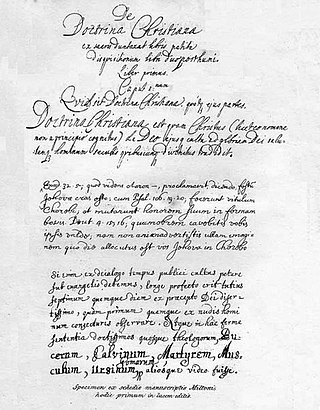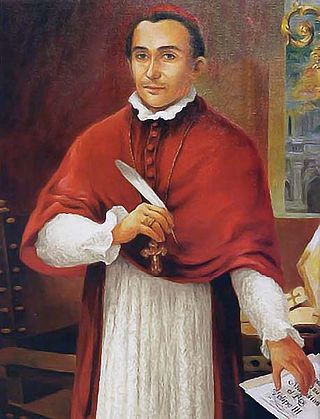
A catechism is a summary or exposition of doctrine and serves as a learning introduction to the Sacraments traditionally used in catechesis, or Christian religious teaching of children and adult converts. Catechisms are doctrinal manuals – often in the form of questions followed by answers to be memorised – a format that has been used in non-religious or secular contexts as well. According to Norman DeWitt, the early Christians appropriated this practice from the Epicureans, a school whose founder Epicurus had instructed to keep summaries of the teachings for easy learning. The term catechumen refers to the designated recipient of the catechetical work or instruction. In the Catholic Church, catechumens are those who are preparing to receive the Sacrament of Baptism. Traditionally, they would be placed separately during Holy Mass from those who had been baptized, and would be dismissed from the liturgical assembly before the Profession of Faith and General Intercessions.

The Catholic Bishops' Conference of the Philippines (CBCP) is the permanent organizational assembly of the Catholic bishops of the Philippines exercising together certain pastoral offices for the Christian faithful of their territory through apostolic plans, programs and projects suited to the circumstances of time and place in accordance with law for the promotion of the greater good offered by the Catholic Church to all people.

As part of the worldwide Catholic Church, the Catholic Church in the Philippines, or the Filipino Catholic Church, is under the spiritual direction of the Pope. The Philippines is one of the two nations in Asia having a substantial portion of the population professing the Catholic faith, along with East Timor, and has the third largest Catholic population in the world after Brazil and Mexico. The episcopal conference responsible in governing the faith is the Catholic Bishops' Conference of the Philippines (CBCP).

Pieter van der Moere, also known as Brother Pedro de Gante or Pedro de Mura was a Franciscan missionary in sixteenth century Mexico. Born in Geraardsbergen in present-day Belgium, he was of Flemish descent. Since Flanders, like Spain, belonged to the Habsburg Empire and he was a relative of King Charles V, he was allowed to travel to the colonies of New Spain as one of a group of Franciscan friars. Gante's group in fact arrived before the 12 Franciscans normally thought of as the first friars in New Spain. In Mexico he spent his life as a missionary, indoctrinating the indigenous population in Christian catechism and dogma. He learned Nahuatl, the language of the Aztecs, and composed a Christian "doctrina". One of his most significant contributions to Mexico was the creation of the School of San Jose de los Naturales. This was the first school set up by Europeans in the Americas.

Catholic Media Network, also known as CMN, is a Catholic radio network in the Philippines. CMN serves as the broadcasting arm of the Catholic Bishops' Conference of the Philippines, the governing body of the Roman Catholic Church in the Philippines.
Theobald Stapleton, alias Teabóid Gálldubh, was an Irish Roman Catholic priest born in County Tipperary, Ireland. Little is known of his career, except that he was a priest living in Flanders.
Events from the year 1639 in Ireland.

Romulo Geolina Valles, is the current archbishop of the Archdiocese of Davao in Davao City, on the island of Mindanao, Philippines and the president of the Catholic Bishops' Conference of the Philippines since December 1, 2017. He was the former archbishop of Zamboanga before being appointed to the Davao see.

De Doctrina Christiana is a theological treatise of the English poet and thinker John Milton (1608–1674), containing a systematic exposition of his religious views. The Latin manuscript "De Doctrina" was found in 1823 and published in 1825. The authorship of the work is debatable. In favor of the theory of the non-authenticity of the text, comments are made both over its content, and it is difficult to imagine that such a complex text could be written by a blind person. However, after nearly a century of interdisciplinary research, it is generally accepted that the manuscript belongs to Milton. The course of work on the manuscript, its fate after the death of the author, and the reasons for which it was not published during his lifetime are well established. The most common nowadays point of view on De Doctrina Christiana is to consider it as a theological commentary on poems.

The Roman Catholic Archdiocese of Tuguegarao is a Latin Church metropolitan archdiocese of the Catholic Church in the Philippines. Tuguegarao is a river delta city that became center of the archdiocese in the Province of Cagayan, on the island of Luzon. Its seat is located at the Saint Peter the Apostle Metropolitan Cathedral.
In the Catholic Church, the Precepts of the Church, sometimes called the Commandments of the Church, are certain laws considered binding on the faithful. As usually understood, they are moral and ecclesiastical, broad in character and limited in number. In modern times there are five.

The Roman Catholic Diocese of Tarlac is a diocese of the Roman Catholic Church comprising the whole civil province of Tarlac in the Philippines. The see is the Saint Sebastian Cathedral in Tarlac City.

Sócrates "Soc" Buenaventura Villegas O.P. is a Filipino prelate, and a professed member of the Dominican Order, He is the current Archbishop of Lingayen-Dagupan in Pangasinan, and is the former president of the Catholic Bishops' Conference of the Philippines, from December 1, 2013 to December 1, 2017, when he finished his second and final term as president of the said conference. He was also the vice president of the episcopal conference from 2011 to 2013. He had previously served as Auxiliary Bishop of Manila from 2001 to July 3, 2004, and third Bishop of Balanga in Bataan from July 3, 2004 to November 4, 2009 where he succeeded Honesto F. Ongtioco who became Bishop of Cubao in Quezon City on August 28, 2003.

Miguel de Benavides y Añoza, O.P. was a Spanish clergyman and sinologist who was the third Archbishop of Manila. He previously served as the first Bishop of the Diocese of Nueva Segovia, and was the founder of the University of Santo Tomas in Manila.
Juan Cobo OP was Spanish Dominican missionary, diplomat, astronomer and sinologist.

University of Santo Tomas Publishing House (USTPH) is a Filipino academic and literary publishing house. USTPH, in its current form, was established in 1996. It was inspired by the four-century-old UST Press, which was founded in 1593. USTPH, formerly the UST Press, is the oldest continuing press in Asia today. It is even older than the University of Santo Tomas, which was established in 1611. At present, it is equipped with high quality printing machines from Germany and advanced computer technology from the United States, Japan, and other countries. The USTPH aims to provide extensively the creative and innovative outputs of the academe, not only within, but also outside the campus.

Gilbert Armea Garcera is the Roman Catholic Archbishop of the Archdiocese of Lipa in the Philippines. He succeeds Archbishop Ramon Arguelles, who earlier filed his resignation prior to his mandatory retirement age in 2017. His previous assignment was the bishop of the Diocese of Daet in Camarines Norte.

The Doctrina Christiana were two early books on the catechism of the Catholic Church, both published 1593 in Manila, Philippines. These are two of the earliest printed books in the Philippines.
This is a timeline of the history of the Pontifical and Royal University of Santo Tomas, the oldest university in Asia, comprising important events of the history of the university and of the development of Philippine higher education in general. To read about the background to these events, see History of the University of Santo Tomas. See also the history of the Rector Magnificus of the University of Santo Tomas, and the Santo Tomas Internment Camp
Old Tagalog, also known as Old Filipino, is the earliest form of the Tagalog language during the Classical period. It is the primary language of pre-colonial Tondo, Namayan and Maynila. The language originated from the Proto-Philippine language and evolved to Classical Tagalog, which was the basis for Modern Tagalog. Old Tagalog uses the Tagalog script or Baybayin, one of the scripts indigenous to the Philippines.














